mica - Aluminum and other silicate minerals. It is found usually in granite, either in scales or crystals.
middle ground - The part of an artwork that lies between the foreground (nearest to the viewer) and the background.
mihrab - In Islamic architectural tradition, the most important element in any mosque, the niche that indicates the direction of Mecca (qiblah). Because it functions as the focal point in prayer ritual, its decoration was and continues to be executed with great skill and devotion.
Examples:

Iran, Mihrab
from the Madrasa Imami in Isfahan, 755 AH
/ c. 1354 CE,
mosaic of monochrome-glaze tiles
on composite body set on plaster,
11 feet 3 inches x 7 feet 6 inches (343.1 x 288.7 cm), Metropolitan
Museum of Art, NY.

Egypt, Cairo, Mihrab and Minbar of the Mosque of Sultan Hasan,
1356-1360. This liwan, or niche is the side of the mosque used
as a madrasa by the Shafi,
one of the four schools of Islamic legal and theological thought.
See minbar.

Iran or central Asia, Mihrab, late
fifteenth or sixteenth century, glazed
ceramic tile, 106 1/2 x 89 inches (270.5
x 226.1 cm), Cincinnati Art Museum, OH.
mil - A unit of measurement of the thickness of sheet materials equal to one thousandth of an inch. Paper and plastic sheet materials are most commonly measured this way.
Also see gauge, ream, sheet metal, and weight.
milagro - Milagro is the Spanish word for "miracle."
Milagro is also a term for ex
voto.  In Mexico,
Latin America, and the southwestern United States, milagros are
small metal sculptures (usually made of silver)
that believers present at shrines, typically attaching them to
altars, and to statues
or effigies of saints, etc.,
as votive offerings — promoting
the healing of sickness, successful romance, and the granting
of other requests. When the offering's objective is healing, a
milagro is likely to
In Mexico,
Latin America, and the southwestern United States, milagros are
small metal sculptures (usually made of silver)
that believers present at shrines, typically attaching them to
altars, and to statues
or effigies of saints, etc.,
as votive offerings — promoting
the healing of sickness, successful romance, and the granting
of other requests. When the offering's objective is healing, a
milagro is likely to 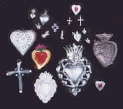 be
in the shape of the afflicted
part of the body.
be
in the shape of the afflicted
part of the body. The Mexican
milagros shown here include a number that are crosses or hearts,
the largest of which is about 3 inches high (7.5 cm).
The milagros shown here are made of base silver and date from the nineteenth century. Also see amulet, charm, fetish, santo, and talisman.
mild steel - Steel which contains only a small proportion of carbon. This is the kind of steel most commonly used for construction of large structures.
Also see iron, metal, and weld.
 millefiori - From the Italian, meaning "a thousand
flowers," millefiori are glass
rods, typically one foot in
length, each with a diameter
of about 3 millimeters. From the outside, they appear to be simple
glass canes. But when seen in cross-section,
each piece reveals a multicolored radial
design, each looking much the same
along the cane's length. Making millefiori requires great craftsmanship, because
millefiori - From the Italian, meaning "a thousand
flowers," millefiori are glass
rods, typically one foot in
length, each with a diameter
of about 3 millimeters. From the outside, they appear to be simple
glass canes. But when seen in cross-section,
each piece reveals a multicolored radial
design, each looking much the same
along the cane's length. Making millefiori requires great craftsmanship, because 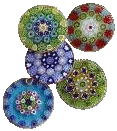 each color
comes from a different mineral, and has its own melting
point. Since every rod is a composition of several colors,
it's important that the artisan
controls the various components' temperatures
in order to fuse the specific
colors in each pattern.
The most reknowned producers of millefiori are the glassmakers
at Murano — an island near Venice. There, millefiori are made
in order to use them in the production of "murrina"
— objects such as beads and paperweights, as made at Murano for
more than 700 years.
each color
comes from a different mineral, and has its own melting
point. Since every rod is a composition of several colors,
it's important that the artisan
controls the various components' temperatures
in order to fuse the specific
colors in each pattern.
The most reknowned producers of millefiori are the glassmakers
at Murano — an island near Venice. There, millefiori are made
in order to use them in the production of "murrina"
— objects such as beads and paperweights, as made at Murano for
more than 700 years.
Also see kaleidoscope.
millennium - A period of a thousand years. Because the first millennium CE began with the year 1 CE, 2000 was the final year of the second millennium, and December 31, 2000 was the last day of the second millennium. From the first day of 2001, we have been living in the third millennium CE.
Also see time.
milliliter - A unit of liquid measurement equal to a cubic centimeter, or 1/1000 of a liter. To convert milliliters into ounces (US, fluid), multiply them by 0.0338. Abbreviated ml.
millimeter - A unit of distance measurement equal to 1/10 of a centimeter, or 1/1000 of a meter. To convert millimeters into inches, multiply them by 0.03937. Abbreviated mm.
minaret - In Islamic
tradition, a tall, slender tower
attached to or built near a mosque.
Every minaret  has
a balcony that a muezzin (Muslim
crier) uses to call the faithful to prayer five times a day.
has
a balcony that a muezzin (Muslim
crier) uses to call the faithful to prayer five times a day.
Nur in Semitic languages means "light." Hebrew
menorah thus means a "holder of light" or "candelabrum."
The Arabic form of the word is manarah, manara,
or manar.
In pre-Islamic Arabia, minarets were high places of light or fire,
and served as beacons or markers to guide caravan routes. Such
towers attached to Byzantine
fortresses along the North African and Syrian coasts were used
as lighthouses. Standing vertically
it serves as a spiritual symbol that
links heaven and earth. The appearance of a single minaret resembles
the numeral "1" which symbolizes unity and oneness.
Some Muslims suggest the association to the first long straight
letter of the Arabic alphabet, alif, with which Allah's name begins.
The "adhan" — the call to prayer made from the minaret
— sung by a muezzin present in the minaret, or a recording of
him amplified by a loudspeaker. To hear a short recording of the
adhan click here.
Also see dikka, mihrab, minbar, and qiblah.
minbar - In Islamic tradition, the pulpit found near the qiblah wall in a mosque used by the Imam (prayer leader) for sermons and prayer. Minbars are made of wood, stone, marble and alabaster, and usually richly decorated.
(pr. MEEN-bahr)
Examples:

Egypt, Cairo, Mihrab and Minbar of the Mosque of Sultan Hasan,
1356-1360. The liwan, or niche to the right of the mihrab,
is the mihrab. This side of the mosque is used as a madrasa
by the Shafi, one of the four schools of Islamic legal and theological
thought.
Also see dikka, mihrab, and minaret.
mind - There are many theories about the human consciousness, leading some to conclude that the mind is one's soul, spirit, or brain. A psychologist might say that the mind is the portion of the brain in which it performs as the conscious and subconscious. Consciousness manifests as feelings, perceptions, thoughts, will, reasoning, memory, and imagination. The mind includes or relies on the parts of the brain in which we process the input of our senses. Here it is that we pay attention, apply knowledge and creativity, form opinions, make decisions, and direct behaviors. In it dwell and are processed concepts, meanings, ambiguities, fantasies, inspirations, mysteries, and motivations.
Quote:

Also see amphibolous, Bloom's Taxonomy, coherence, communication, conceptual, conceptual art, déjà vu, eccentric, effort, empiricism, epistemology, genius, gestalt, iconology, interdisciplinary, mirror, muses, ontology, and virtual reality.
mineral spirits - A petroleum
distillate used as a paint
thinner substituting for
turpentine. It is less expensive
than turpentine, less sticky, and has a less enduring odor. There
is a deodorized version which costs considerably more. Hazardous
in several ways, it is quite flammable,
necessitating special care in its use, storage and disposal. It
is known in Britain as white spirits.
Also see marbling, stain, and stain removal.
Ming - A Chinese dynasty that lasted 1368 - 1644.
Examples of work from the Ming dynasty:
![]()
China,
Ming dynasty, Court Painter, Ming Huang and Yang Gueifei Listening
to Music, 1368-1400, handscroll;
ink and light color on silk,
seals: three interpolated seals
of Qian Zuan (about 1235-after 1300), Worcester Art Museum, MA.
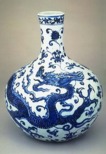
Chinese, Ming dynasty, Yung-lo reign (1403-24),
Celestial
globe vase with dragon and floral design, porcelain painted in underglaze blue, National
Palace Museum, Taipei. See botanical
and chop.

China, Ming dynasty, 1403-1424, Plate with Grape Vine Decoration, blue
and white glazed porcelain,
Museum für Ostasiatische Kunst, Berlin.

China, Bottle-shaped Vase, Ming dynasty, early
15th century, porcelain
with underglaze-blue decoration,
Worcester Art Museum, MA.
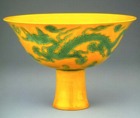
China,
Ming dynasty, mark and period of Hung-chih (reigned 1488-1505),
Stem
cup with dragon motif, porcelain
with yellow and green enamel glaze, National Palace Museum, Taipei.
See motif.
![]()
Wen Zhengming (Chinese, 1470-1559), Bamboo, Orchids, Rock, and Calligraphy,
Ming dynasty, c. 1530, handscroll;
ink on paper;
signature: seals of the artist
in inscription; seals: (upper)
Wen Zhengming yin, (lower) Zheng-Zhung, Worcester Art Museum,
MA. See calligraphy.

China, Ming dynasty, 16th century, Portrait
of Sung Jen-tsung, hanging scroll, ink and color on silk,
National Palace Museum, Taipei. See portrait.
![]()
Ding Yunpeng (Chinese, active 1584-1638),
Landscape with Figures under a Tree,
1616, fan painting; ink
and gold leaf on
paper; signature: Ding Yunpeng; seals: one of the artist and
two of collectors, Worcester Art Museum, MA.
Commentary on art of the Ming dynasty:
Also see blanc de Chine.
minuscule - A small letter. "Minuscule" appeared in the early 18th century as a word for certain ancient and medieval writing styles that had "small forms." Eventually, it came to be used for any lowercase letter. "Minuscule" then acquired a more general adjectival use for anything very small. "Majuscule" is the counterpart to "minuscule" when it comes to letters, although it is not used as the opposite to miniscule in its last sense.
(pr. MI-nə-skyool)
Also see lowercase, miniature, size, and uppercase.
mischio - Italian word for a smoky pattern in marble.
(pr. MEE-shee-o)
miscible - Refers to liquids that can be mixed in all proportions to each other, and they will be completely soluble in each other.
(pr. MIS-sə-bəl)
Also see aqueous, caustic, clean up, detergent, hazardous, solvent, vehicle, viscosity, volatile, water-soluble, wax, and wetting agent.
misericords - Wooden relief carvings in Gothic churches that decorate the undersides of seating ledges provided for clergy during services. Misericords often portray biblical scenes, but many have secular subjects. A great many are grotesque, fantastic, and witty. In England, exemplars are often cited at the cathedrals of Ely, Exeter, Wells, and Lincoln. The word is derived from the Latin word misericordia, which means mercy or pity. A misericord, then, is an expression of God's mercy for the exhausted clergyman who would otherwise have to stand.
Examples:
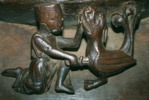
English, Knight Fighting a Dragon, carved
oak, one of the 35 misericords at the cathedral
of St. Peter, Exeter, c. 1279. Three others are Branch Springing from a Dragon's Mouth,
Doves with Strawberry Leaf Between Them,
and the Locust of the Apocalypse.


English, Long-Tongued Grotesque, carved
oak, St. Margaret's Church, Chester, 1370-77.
Another misericord in this church represents
a
demon — an anthropomorphic bat — above two women. See anthropomorphic and representation.
![]()

![]()
French, A Fool Pulling at His Mouth, carved
wood misericord at Rodez, France,
c. 14th century.
mistake -
Quote:
Also see talent.

miter - To cut two pieces of wood (or another material) at 45° so that they align perfectly at right angle. This picture shows how two mitered pieces can then be glued and nailed together. This is often done to produce a painting stretcher, a frame, or some other structure.
Also see adhesives.
mitsuda-e - In Japanese art tradition, a painting medium requiring oil and lead oxide.
mixed media or mixed-media - A technique involving the use of two or more artistic media, such as ink and pastel or painting and collage, that are combined in a single composition. The term intermedia is used synonymously. (Avoid using "multimedia" as a synonym, because that is likely to cause confusion.)
Examples:
Pablo Picasso (Spanish, 1881-1972), Still Life with Chair-Caning, 1912, oilcloth patterned with imitation caning, oil on canvas, and a frame made of rope, 10 1/8 x 13 3/4 inches, Musée Picasso, Paris.
Joseph Cornell (American, 1903-1972), Suzy's Sun (for Judy Tyler), 1957, mixed-media shadow box construction, 10 3/4 x 15 x 4 inches (27.3 x 38.1 x 10.2 cm), North Carolina Art Museum, Raleigh. See sculpture.
Jess [Collins], (American,1923-), The Mouse's Tale, 1951-1954, gelatin silver prints, magazine reproductions, and gouache on paper, 47 x 32 inches (119.3 x 81.2 cm), San Francisco Museum of Modern Art. Visual games and puns are the essence of Jess' works, which he prefers to call "Paste-Ups" because of the term's childlike association.
Edward Kienholz (American, 1927-1994)

Daniel Spoerri (Swiss, 1930-), Prose Poems, 1959-60, mixed
media on wood, 27 1/.8 x 21
3/.8 x 14 1/4 inches (69.0 x 54.2 x 36.1 cm), Tate Gallery, London
— an actual meal as abandoned on a board. See Fluxus, ontbijt,
and rhopography.
Also see float, Fluxus, new media, sculpture, and tradigital.
mizu-e - In Japanese art tradition, a type of print with faintly printed outlines.
Also see nise-e.
ml or ml. - Abbreviation for milliliter.
mm or mm. - Abbreviation for millimeter.

mobile - A construction made of objects that are balanced and arranged on wire arms and suspended so as to move freely.
Alexander
Calder (American, 1898-1976) introduced this art form in the late
1920s and early 1930s. In 1932, a month before he first referred
to his wire sculptures with moving
parts using this term, it was Marcel Duchamp (French, 1887-1968)
who suggested to Calder that he call his pieces "mobiles".
Calder's entire oeuvre was certainly varied — sculptures (including mobiles, stabiles, standing mobiles, and wire sculptures), and monumental outdoor works, as well as oil paintings, works on paper, toys, jewelry, and household objects.
(pr. moh-BEEL)
Examples:
Alexander Calder (American, 1898-1976), Calder's Circus, 1926-31, mixed media: wire, wood, metal, cloth, yarn, paper, cardboard, leather, string, rubber tubing, corks, buttons, rhinestones, pipe cleaners, and bottle caps, 54 x 94 1/4 x 94 1/4 inches (137.2 x 239.4 x 239.4 cm) overall, Whitney Museum of American Art, NY.
Alexander Calder, The Orange Fish, 1946, painted
metal mobile, 75 x 176 inches,
Tehran Museum of Contemporary Art, Iran.
Alexander Calder, Brass in the Sky, 1947, brass, 96 x 120 inches (243.8 x 304.8 cm), Museum of Contemporary Art, Chicago, IL.
Alexander Calder, Untitled, c. 1960, standing mobile, painted metal, 30 x 22 x 14 inches, Baruch College.
Related Links:
Also see animation, automata, bricolage, Dada, four-dimensional, kinesiologist, kinetic, movement, rhythm, space-time, and time.
modeling or modelling -  A sculpture
technique in which a three-dimensional form
is manipulated in a soft material such as clay
— either modeling clay (Plasticine
is a well-known brand) or ceramic
clay — or wax.
The term also refers to the effect of light
on a three-dimensional form. The three-dimensional quality
of such a form is emphasized by means of light, shadow,
and color. Reproducing
the effect of light, shadow, and color in a drawing
of such a form makes it seem more realistic.
For example,
A sculpture
technique in which a three-dimensional form
is manipulated in a soft material such as clay
— either modeling clay (Plasticine
is a well-known brand) or ceramic
clay — or wax.
The term also refers to the effect of light
on a three-dimensional form. The three-dimensional quality
of such a form is emphasized by means of light, shadow,
and color. Reproducing
the effect of light, shadow, and color in a drawing
of such a form makes it seem more realistic.
For example, Masaccio (Italian, 1401 - c. 1428) modeled the figures in his painting of The Holy Trinity to make them appear
solid and round.
Related resource:
Also see aggregate, chiaroscuro, pinch, polymer clay, Prometheus, shape, value, and wireframe.
modeling clay - A nonhardening substance used for modeling sculptures
— 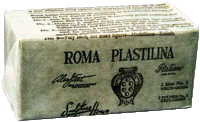 for sketches, models for casting,
and by students. It is plastic
(in the sense of being workable). It cannot be used for permanent
work (unlike ceramic water-based
clays, it is never fired
or glazed).
for sketches, models for casting,
and by students. It is plastic
(in the sense of being workable). It cannot be used for permanent
work (unlike ceramic water-based
clays, it is never fired
or glazed). 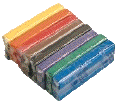 Although it becomes
less useful as its oil either dries or is absorbed from it (making
it brittle) or as it picks up impurities, but it can be reused
for many years if kept relatively clean. Even new it can vary
greatly in quality. Most common
varieties are made of clay mixed with petroleum greases, oils
(typically linseed oil),
turpentine, sulfur dioxide,
and pigments. It softens as
it is modeled by the hands (because of their warmth), pieces joined
to each other by pressing them together and blending with fingertips.
Equipment that might be used with modeling clay include modeling
tools and armatures. Molds can be made from modeling
clay. There are numerous commercially produced types, including
the brand named Plasticine.
It is sometimes called model clay.
Although it becomes
less useful as its oil either dries or is absorbed from it (making
it brittle) or as it picks up impurities, but it can be reused
for many years if kept relatively clean. Even new it can vary
greatly in quality. Most common
varieties are made of clay mixed with petroleum greases, oils
(typically linseed oil),
turpentine, sulfur dioxide,
and pigments. It softens as
it is modeled by the hands (because of their warmth), pieces joined
to each other by pressing them together and blending with fingertips.
Equipment that might be used with modeling clay include modeling
tools and armatures. Molds can be made from modeling
clay. There are numerous commercially produced types, including
the brand named Plasticine.
It is sometimes called model clay.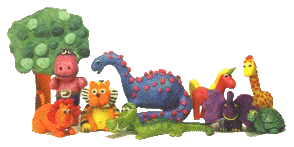
Some of the additives in oil-based
clays, such as turpentine and ![]()
preservatives, might cause skin irritation
or allergies, and sulfur dioxide might cause some respiratory
problems in certain asthmatics. The amounts present are usually
small. Use gloves or apply a barrier cream to hands if skin irritation
results from using modeling clays. Clean hands well after contact
by washing them with soap and water.
Also see Material Safety Data Sheet (MSDS) and polymer or PVC clay.

modeling tools - Tools for working with or modeling clay. The examples shown here are each six inches long, hand carved and polished in boxwood. Modeling tools can also be made in plastic and metal. They can also be improvised with such things as "popsicle" or "craft" sticks, dowels, table knives, spoons and forks. Lots of other workable things may well be found in kitchens drawers and among your hardware stuff.
Also see ceramics, loop tool, plasticity, subtraction, and wood.
modern - Generally refers to recent times or the present, or the sense of something being contemporary or up-to-date, recently developed or advanced in style, technique, or technology. Sometimes this refers to something being innovative or experimental. Compare and contrast this with moderne, modernism, and postmodernism.
Quote:
Also see avant-garde, new, and new media.
moderne - Striving to be modern in appearance or style but lacking taste or refinement; pretentious. A spelling more common in the 1930s to 1950s.
(pr. moh-DəRN)
Also see Art Deco.
Modernism or modernism - An art movement characterized by the deliberate departure from tradition and the use of innovative forms of expression that distinguish many styles in the arts and literature of the late nineteenth and early twentieth centuries. Modernism refers to this period's interest in:
Paul Cézanne (French, 1839-1906) is often called the "Father of Modernism."
The modern period is generally thought to have been followed by the one we are in now — most often called postmodern. Although some prefer to call it "late modern."
Quote:
Other resources concerned with Modernism:
Also see avant-garde, isms and -ism, modern, moderne, new, new media, and postmodernism.
module - A basic unit of which the dimensions of the major parts of a work are multiples. The principle is used in sculpture and other art forms, but it is often most employed in architecture, where the module may be the dimensions of an important part of a building, such as a column, or simply some commonly accepted unit of measurement (the meter or the foot, or, as with Le Corbusier, the average dimensions of the human figure).
(pr. MAH-dyəl)
Example of modular work:
Constantin Brancusi (French, born Romania, 1876-1957), Endless Column, 1937-38, metal-coated cast-iron modules on a steel spine, height 98 feet, Târgu-Jiu, Romania. It was restored and reassembled in 2000, as seen here. Endless Column is one of three elements in a sculptural ensemble. the other two works are the travertine Table of Silence and the Gate of the Kiss. The Endless Column was conceived as a monument to young Romanians who died in World War I. See column and vertical.
Mohs Scale of Hardness or Mohs Scale - A scale for classifying stones based on relative hardness, determined by the ability of harder minerals to scratch softer ones. The scale includes the following minerals, in order from softest to hardest:
| Mohs Index | Rock |
|---|---|
| 1 | talc |
| 2 | gypsum |
| 3 | calcite |
| 4 | fluorite |
| 5 | apatite |
| 6 | orthoclase |
| 7 | quartz |
| 8 | topaz |
| 9 | corundum |
| 10 | diamond |
The scale is named for mineralogist Friedrich Mohs (German, 1773-1839). Also see measurement and science and art.
moiré or moire or moir -  Fabric,
especially silk, rayon, linen, or another material
with a wavy or rippled pattern
or texture impressed into its
surface by engraved rollers.
Fabric,
especially silk, rayon, linen, or another material
with a wavy or rippled pattern
or texture impressed into its
surface by engraved rollers.  Originally moiré was a mohair
fabric with this lustrous
finish. ("Moiré"
was first a French word that was probably a modification of the
English word "mohair.") This kind of fabric is also
called "watered," as in "watered silk." The
water reference is to moiré's resemblance to gentle waves
on water. The process of producing
these products has nothing to do with water.
Originally moiré was a mohair
fabric with this lustrous
finish. ("Moiré"
was first a French word that was probably a modification of the
English word "mohair.") This kind of fabric is also
called "watered," as in "watered silk." The
water reference is to moiré's resemblance to gentle waves
on water. The process of producing
these products has nothing to do with water.
(pr. MWAH-ray)
Another example:

Agostino Lauro (Italian, 1861-1924), Sofa, 1900-1901, mahogany with silk moiré, the Mitchell Wolfson Jr.
Collection, The Wolfsonian-Florida International U, Miami Beach,
FL.
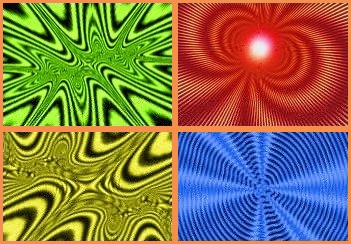 When materials with repetitive
lines overlap, moiré
patterns
result. Several phenomena
occur in the overlapping of repetitive layers, whether monochrome
or
When materials with repetitive
lines overlap, moiré
patterns
result. Several phenomena
occur in the overlapping of repetitive layers, whether monochrome
or 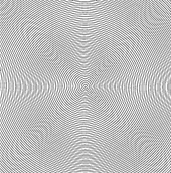 polychrome, periodic
or non-periodic. Moving one pattern over another can generate
fascinating optical effects.We see these effects when looking through two sets of similar
screen or fence materials, and their patterns are not perfectly
aligned. An even handier
demonstration of this phenomenon can be observed while overlapping
two combs. See an animated demonstration of a moiré fringe
pattern — a shadow moiré: one of the patterns is a
shadow of the other pattern.
polychrome, periodic
or non-periodic. Moving one pattern over another can generate
fascinating optical effects.We see these effects when looking through two sets of similar
screen or fence materials, and their patterns are not perfectly
aligned. An even handier
demonstration of this phenomenon can be observed while overlapping
two combs. See an animated demonstration of a moiré fringe
pattern — a shadow moiré: one of the patterns is a
shadow of the other pattern.
Moiré is also found in
interference of multiple dot-grid textures of halftone
patterned images — an allover murky, herringbone or crosshatched or dotted pattern.
Generally unwanted, these patterns result from two uses of a picture with a halftone pattern
(a strong magnifying glass will show it, whether B&W or CMYK); as 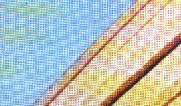 when such
a picture is reproduced,
whether by analog or by digital means. Beware, for instance,
of scanning halftone pictures
printed in magazines, newspapers, calendars, postcards, etc. (not
to mention the copyright issue, a serious consideration in itself). Moiré patterns
often appear all over such scans, caused by interference between
the first set(s) of fine pattern halftone grids (133 or 150 lpi)
and the grid of pixels created
in a digital version of the picture (300 or 600 dpi scanner CCD array). These
combine into maximums or minimums every several pixels in the
image, depending on the spacing of the dots. This affects the
overall light intensity in periodic patterns that
become very visible. Moiré effects can be diminished by
the use of sharpening and unsharpening filters.
when such
a picture is reproduced,
whether by analog or by digital means. Beware, for instance,
of scanning halftone pictures
printed in magazines, newspapers, calendars, postcards, etc. (not
to mention the copyright issue, a serious consideration in itself). Moiré patterns
often appear all over such scans, caused by interference between
the first set(s) of fine pattern halftone grids (133 or 150 lpi)
and the grid of pixels created
in a digital version of the picture (300 or 600 dpi scanner CCD array). These
combine into maximums or minimums every several pixels in the
image, depending on the spacing of the dots. This affects the
overall light intensity in periodic patterns that
become very visible. Moiré effects can be diminished by
the use of sharpening and unsharpening filters.
Also see analog-to-digital conversion, curve, Art Nouveau, digital image, image resolution, output resolution, and straight.
https://inform.quest/_art